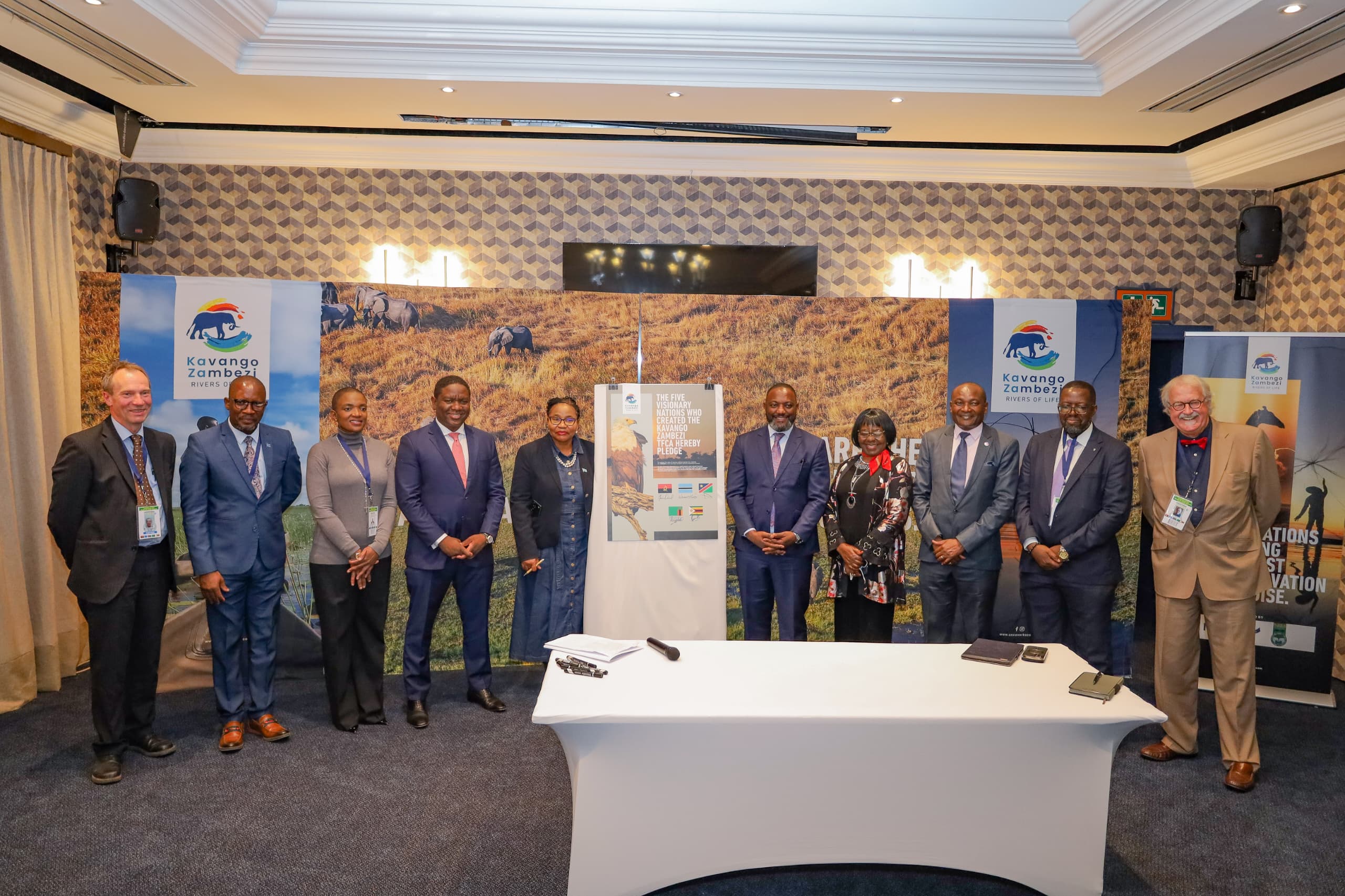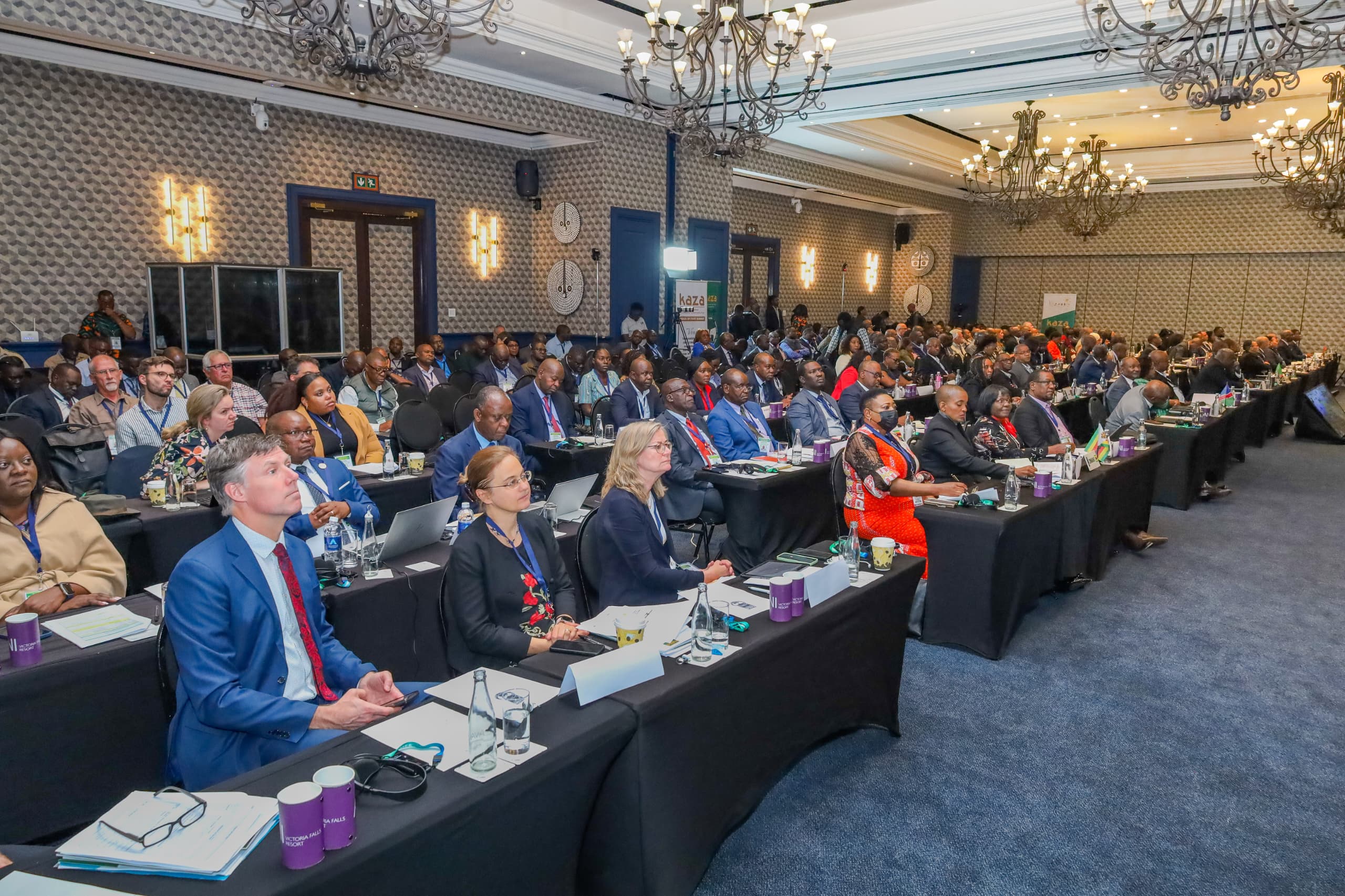AWF's Key Takeaways from Recent KAZA Heads of State Summit

At the KAZA Summit Ministers Session on May 29th, the attending Ministers gathered for a group photo to commemorate the launch of the KAZA Tourism Destination Brand.
The Southern Africa region boasts an incredible variety of ecosystems and landscapes, from lush tropical forests to expansive grasslands and arid terrains. This region harbors over 25% of the world’s population of endangered wild dogs and approximately 50% of the world’s savanna elephant population, along with other unique wildlife species. However, the transboundary nature of this wildlife creates a complex web of challenges for conservation efforts.
The Kavango-Zambezi Transfrontier Conservation Area (KAZA TFCA) was established in 2011 to promote collaborative conservation across Zimbabwe, Zambia, Namibia, Angola, and Botswana. It spans the Kavango and Zambezi River basins and covers an area larger than Germany and Austria combined, aiming to protect shared natural resources.
Last month, the first KAZA Heads of State Summit was held in Livingstone, Zambia. The summit focused on collaborative strategies to boost conservation initiatives and promote the region as a premier tourism destination. We interviewed African Wildlife Foundation (AWF) Zimbabwe Country Director Olivia Mufute, who offered insights into the summit’s key discussions and outcomes. From the onset, AWF has been pivotal in driving the development of the KAZA TFCA by advocating for cross-border resource management and cooperation. AWF’s early efforts through the “Four Corners Transboundary Natural Resource Management Area” set a precedent for collaboration among the countries involved.
AWF Zimbabwe Country Director, Olivia Mufute during her presentation at the KAZA TFCA Heads of State Summit in Zambia
Q: Can you give an overview of the KAZA TFCA and its role in wildlife conservation?
Olivia: The KAZA TFCA, established through a Memorandum of Understanding in 2006 and a subsequent treaty in 2011, is envisioned as a premier conservation and tourism destination within the Kavango-Zambezi region, promoting sustainable development. Spanning roughly 520,000 square kilometers across parts of Angola, Botswana, Namibia, Zambia, and Zimbabwe, it stands as the world’s largest terrestrial TFCA. Its creation aims to preserve wildlife on a grand scale and foster sustainable development by synchronizing policies, strategies, and practices that benefit both the regional fauna and the local communities.
Q: What significant decisions and pledges were made at the latest summit of KAZA heads of state?
Olivia: The summit’s leaders pledged to enhance the KAZA area’s natural capital value. They agreed to swiftly implement the SADC CITES Engagement Strategy to represent the region’s interests at the 2025 CITES COP20. A preparatory meeting is set for August 2024 in Botswana to unify their stance for the conference. They are considering various approaches, including diplomatic efforts, potential withdrawal, trading with non-CITES nations, reservations, and arbitration.
The leaders also resolved to ratify the KAZA TFCA Livelihoods Diversification Strategy, and a Climate Change Risk Assessment focused on livelihoods. The leaders are committed to aligning policies, laws, and institutional structures. This encompasses carbon trading, forestry, community-based resource management, wildlife ownership, and livestock disease management. Furthermore, the summit marked the debut of the KAZA Destination Brand and a training center for rangers and protected area managers. Immediate actions include implementing the KAZA Brand, the KAZA UNIVISA system, and improving regional connectivity through direct flights and efficient border and infrastructure systems.
Q: Were there any specific challenges addressed at the summit? If so, how will they be tackled?
Olivia: The KAZA Heads of State Summit served a critical purpose. It provided a platform for member states to come together and identify the challenges and opportunities facing the KAZA region. Some challenges highlighted include limited sustainable financing, inconsistent policies, international agreements misaligned with the region’s interests, and limited connectivity across the KAZA member states. There was an overarching commitment to approve regional development plans and adopt cross-sectoral integrated land use plans that will harmonize development. The leaders also pledged to adopt and implement the KAZA UNIVISA, along with a commitment to enhance direct flight connectivity, border management systems, and air and road infrastructure. Lastly, in the pursuit of sustainable finance, the leaders committed to capitalizing on the KAZA Fund and ensuring timely contributions to the fund for the region’s development.

Delegates at the KAZA TFCA Heads of State Summit in Zambia
Q: How has AWF’s historical involvement in the KAZA landscape contributed to the current conservation efforts?
Olivia: AWF’s historical involvement in the KAZA landscape has been foundational for current conservation efforts. The ‘Four Corners Project’ provided essential outputs such as surveys, land use plans, and wildlife corridor maps, which were instrumental in the development of the KAZA TFCA. AWF’s research on wildlife movement and corridor mapping, particularly predator collaring research, has been critical. Initiatives like the Ngoma Safari Lodge have demonstrated successful models of community ecotourism that benefit conservation and local well-being. Moreover, AWF’s strategic planning has been pivotal in elephant management, and its support in developing the Hwange General Management Plan has established a framework for sustainable conservation practices.

AWF Zimbabwe Country Director, Olivia Mufute at the KAZA TFCA Summit in Zambia
Q: What opportunities does the KAZA TFCA landscape present for AWF?
Olivia: The KAZA TFCA landscape offers AWF numerous opportunities to leverage its expertise and past successes to enhance future conservation initiatives. AWF can provide technical assistance with GIS and spatial tools, and land use planning, utilizing its extensive in-house capacity. Securing wildlife migratory corridors and developing communal wildlife conservancies are key areas where AWF can support and partner with local communities. Additionally, the El Niño-induced drought highlights the need for AWF’s spatial analyses and documentation capabilities. Collaborating with multiple partners, AWF can share experiences and lessons from the Mid-Zambezi Valley, such as cross-border collaboration, to further conservation goals in line with the sustainable development objectives of KAZA.
Q: What are your goals for wildlife conservation in the KAZA TFCA in the future?
Olivia: I hope to see the KAZA TFCA evolve into a model for sustainable wildlife conservation. The recent KAZA Heads of State Summit emphasized the importance of sharing case studies to enhance the wildlife economy. The Zimbabwe Biodiversity Economy Report, featured in the World Bank’s GEF 8 Global Wildlife Program Project Guidebook, serves as a prime example for others. This inclusion not only facilitates knowledge exchange among KAZA Member States but also extends to the broader SADC region. Looking forward, I envision the KAZA TFCA developing into a thriving ecosystem where wildlife populations and habitats are maintained in a manner that is ecologically sound, economically beneficial, and socially responsible, ultimately supporting the prosperity of local communities.